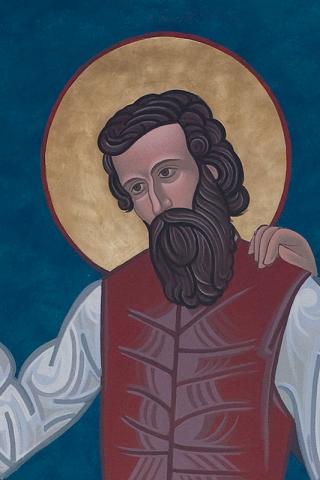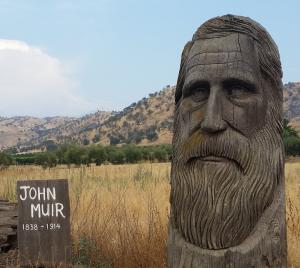Speaking of nature mystics, and saints and paragons of the nature way, I find myself thinking of John Muir.
The always lovely Episcopal Church commemorates the life and work of the Scottish-American naturalist on the 22nd of April. Actually he was born the day before, the 21st of April in 1838.
And I noted all of this in April.
However, birthdays are not the normative anniversary for commemoration in Christian liturgical calendars. But, as he died on the 24th of December, actually this day in 1914, we can see why that particular day would be inconvenient for marking anyone out for special attention. Given all that is going on in this particular season, after all.
I wrote much of what follows back in April, I felt Muir is so important it was nice to be able to recall him one more time. And, it allowed me to make a couple of changes, as well…
Last year Jan & I spent some time exploring Yosemite and Sequoia National Parks. All along our way we discovered our constant companion was John Muir.
He certainly was a person of multiple parts. Of particular note the naturalist was central in the saving of these areas for posterity. But, he was also a scientist, a forester, a mountaineer, well, the list goes on.
But, most important for me was being introduced to his mystical side. He was something amazing…
John Muir is perhaps the great exemplar of nature mysticism, the way of wisdom that looks to nature as mirror of the human heart, as a path to walk, and as the pure expression of what is: a terrible beauty that includes all things. Among the so-called world religions, Daoism, the Watercourse Way, is perhaps the most profound expression of nature mysticism. And through its impact on Chinese Buddhism, a central current in the expression as well as the experience of Zen.
It is also the place where I find American Unitarianism is able to touch Zen. And why of the various Transcendentalists, the mystical element of Nineteenth century Unitarianism, it is the great nature mystic Henry David Thoreau that I find so compelling. As it happens Muir discovered Thoreau as well as Ralph Waldo Emerson while a student at the University of Wisconsin. And read both of them deeply, most obviously, I would say, Thoreau. In fact Muir’s personal collection of the twenty-volume Writings of Henry David Thoreau was heavily annotated in Muir’s hand.
I am particularly taken with what seems to be how both men, Thoreau and Muir took to sauntering as a spiritual practice. And for me how walking as meditation is in fact one of the traditional Buddhist disciplines.
As a small footnote, I was surprised but not shocked to learn that Muir was also connected to Thomas Starr King in his drive to save the High Sierras and particularly the Yosemite valley from mindless exploitation. King the great Universalist and Unitarian minister who is best known for his part in California entering the Union as a free state was also caught up in the mystical experience of the mountains and was in fact a close collaborator with Muir.
But, while I find the connection to Unitarianism interesting, Muir in some ways seems a deeper explorer into the ways of the heart than any of the Transcendentalists. He took some guidance from those elders, but then turned his body and heart toward the wilderness as the true teacher. As he would later write “Even open-eyed Thoreau would perhaps have done well had he extended his walks westward to see what God had to show in the lofty sunset mountains.”
And he did. And he learned. He became one of our most wondrous nature mystics.
And, a great gift to us, he wrote.
I rummaged around the web and found a few selected quotes as a sampler. I’m am not sure of the source for most of them, so I offer this little bouquet with a caution.
Still, a sample of the wisdom of John Muir. Daoist Master. Zen Master. Master of the Original Way.
First, he understood the problem of the human heart. Or, at least a critical aspect of it.
“Most people are on the world, not in it– having no conscious sympathy or relationship to anything about them– undiffused seporate, and rigidly alone like marbles of polished stone, touching but separate.”
And, he posited a fix.
“The mountains are calling and I must go.”
And, once there.
“Between every two pines is a doorway to a new world.”
Between those two pines he found the path of awakening.
“Climb the mountains and get their good tidings. Nature’s peace will flow into you as sunshine flows into trees. The winds will blow their own freshness into you, and the storms their energy, while cares will drop away from you like the leaves of Autumn.”
He took every moment and every experience as a gateway.
“I was awakened by a tremendous earthquake, and though I hadn ever before enjoyed a storm of this sort, the strange thrilling motion could not be mistaken, and I ran out of my cabin, both glad and frightened, shouting, ‘A noble earthquake! A noble earthquake’ feeling sure I was going to learn something.”
And then he pointed the way out for us.
“When we contemplate the whole globe as one great dewdrop, striped and dotted with continents and islands, flying through space with other stars all singing and shining together as one, the whole universe appears as an infinite storm of beauty.”
So, in response to that mistaken sense of isolation, he pointed us in a different direction.
“When one tugs at a single thing in nature, he finds it attached to the rest of the world.”
And, he invited us all to find the whole way, the Original Way.
“Let children walk with Nature, let them see the beautiful blendings and communions of death and life, their joyous inseparable unity, as taught in woods and meadows, plains and mountains and streams of our blessed star, and they will learn that death is stingless indeed, and as beautiful as life.”
The image of John Muir is a detail from a larger piece titled “Dancing Saints” by Mark Dukes at St Gregory of Nyassa Episcopal Church in San Francisco.












